https://urbannext.net/care-full-neighborhoods/
| Care-full Neighborhoods: From Care Venue to Care Ecology https://urbannext.net/care-full-neighborhoods/ |
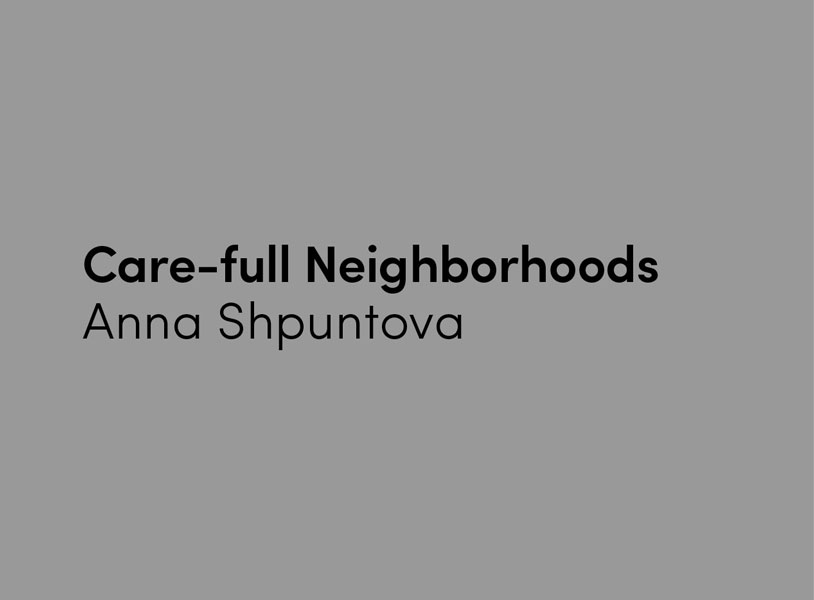
Categories: Anna Shpuntova, Essay, Middle Density, Politics and economics, Territory and mobility, Urban Paradigms
“Care is a surprisingly short word, considering the whole cosmos of professions, sciences and demographics that are included in a holistic understanding of it.”
The interest in the very science of who we are as subjects of health has allowed us to generate over the last decades the widest system of therapies, services and environments associated with health, wellbeing and lifestyle (e.g., serviced and assisted living, nutritional, lifestyle and genetic therapies, pharmacological and sport facilities, etc.). The more these proliferate, the more possible interpretations one can give to the notion of care and the more various locations for these services one sees emerging in our cities. Broadening and interlacing of care services allows us as individuals to take personal responsibility for shaping our own care environments and including them into our changing lifestyle patterns.
These changes coincide with the shift in the attitude to our living environments and general interest in more collective ways of living where balanced sharing of resources, services and responsibilities is something we desire, whether as families, individuals, retirees or young professionals. The offer of well-being and healthcare embedded into our housing environments is the tool that would allow us to start consolidating our thinking about care into thinking about the urban value it offers.
We would claim that today we are not treating the networked distribution of care services in a strategic way that would allow to bring benefit to development of our cities. If we shift from understanding designing for care as an architectural question at a scale of a single venue and its immediate context to care as an ecology that drives the urban change, we will discover the potential of care environments to reinvent our neighborhoods and their vocation. This means recognizing the spatial complexity of such care ecologies as well as diversity of urban settings where they can thrive and boost change. A care ecology as opposed to a care venue suggests a system that allows actors and stakeholders of different scale and vocation to see the relevance of working in a joint-up way or contributing to a bigger network, managing the resources and land together. A network where the whole becomes greater than the sum of its parts, which is flexible enough however to become an alternative to the rigidness of a master planning approach.
We are therefore going to investigate a morphological and typological framework that would allow us to broaden our understanding of care to questions of sport, well-being services, vocational learning, food and event-oriented environments, intergenerational knowledge exchange and various versions of living. We will also investigate how an ecology of care creates crossovers with our domestic realm and how it changes the way we prefer to live today.
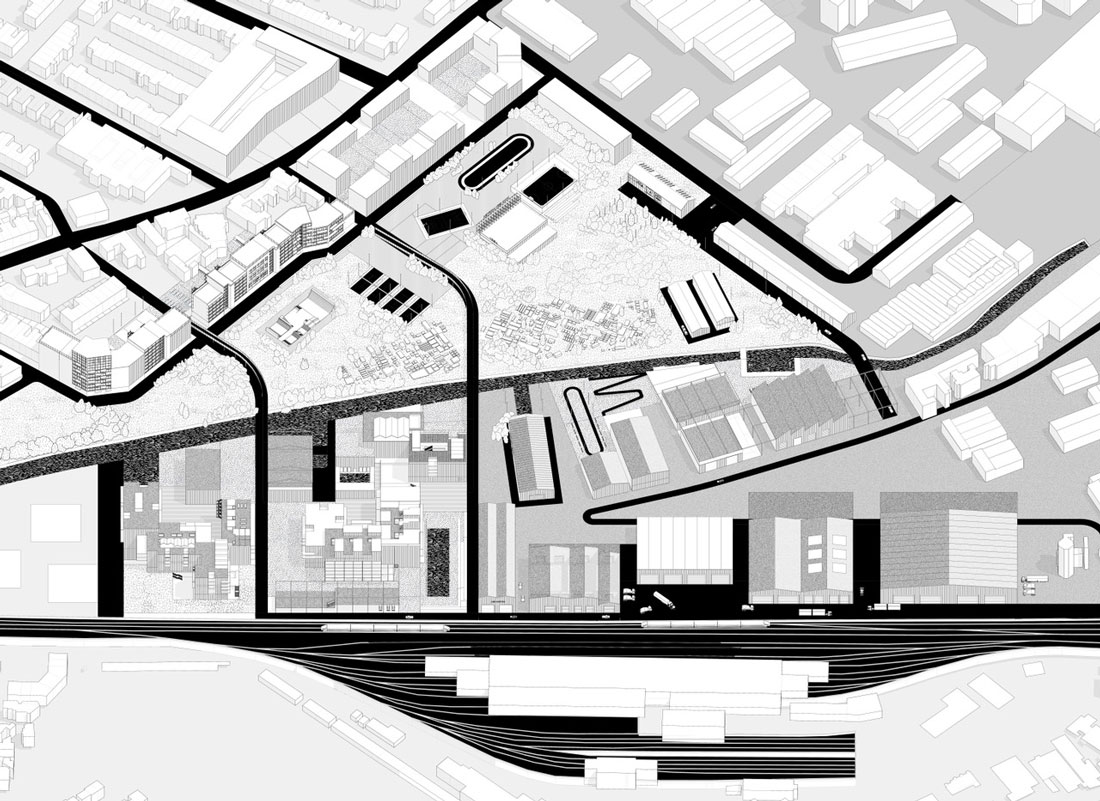
While it is unarguable that today the industry of health and well-being is a growing sector that receives a lot of investment, we are not fully benefiting from it in terms of the urban value for our cities. Policies like ‘The London Plan’ or ‘Housing Design Quality and Standards’ do give us guidance on how and where the environments of care should be built, this guidance most often does not look at care provision beyond the logistics of care delivery or technical requirements for spatial elements, the width of the doors, noise cancellation parameters, etc. The healthcare system in the UK is structured in a way that leaves major stakeholders like the NHS on the periphery of the actual process of care provision as it is delivered by specific care providers at the bottom of the system. This also contributes to the inability of the city to take full advantage of the care environments and address them holistically.
Traditionally, the picture of old age that exits in our society is a very uniform one. However, with greater age people become less and less alike. In fact, senior citizens are an extremely heterogenous group. ‘In addition to their different educational, social, cultural and political identities, which remain unchanged, their financial situations vary.’ In addition to that, in a late-living society like ours, people are staying active and productive much longer, and we often underestimate the range of activities and services they require to lead a full and productive life. With the understanding that ownership is not necessarily an answer today, there is a growing interest in BTR models and all forms of collective living. Such models are built around an idea of bringing with them an additional offer of infrastructure that can cater to the surrounding area. These models are particularly attractive for those who are willing to downsize their households (e.g., seniors) but are not ready to give up on the services and amenities associated with city living. They give people a chance to have access to a health and well-being offer that they wouldn’t be able to afford as a family or an individual by managing it collectively.
In the background of these trends, there is an ambition on the part of the NHS to establish a fully integrated community-based health care. There is an investment into systems of health and well-being that would create crossover with our living environments. Finally, as hospitals become more and more specialized, more and more care services get outsourced, and there is a growing pressure on the care staff as they need to have a wider set of skills and be well trained. Hence, there is a growing understanding among care providers that they not only need to recruit talent but also to retain it. This becomes possible when environments of care come together with educational institutions, hospitals, and other stakeholders that bring with them opportunities for additional training, practice and education.
Altogether, the described trends give us reason to believe that care models have a tremendous potential in terms of the infrastructure and offer they can bring with them to local neighborhoods and start spreading them across wider urban areas.
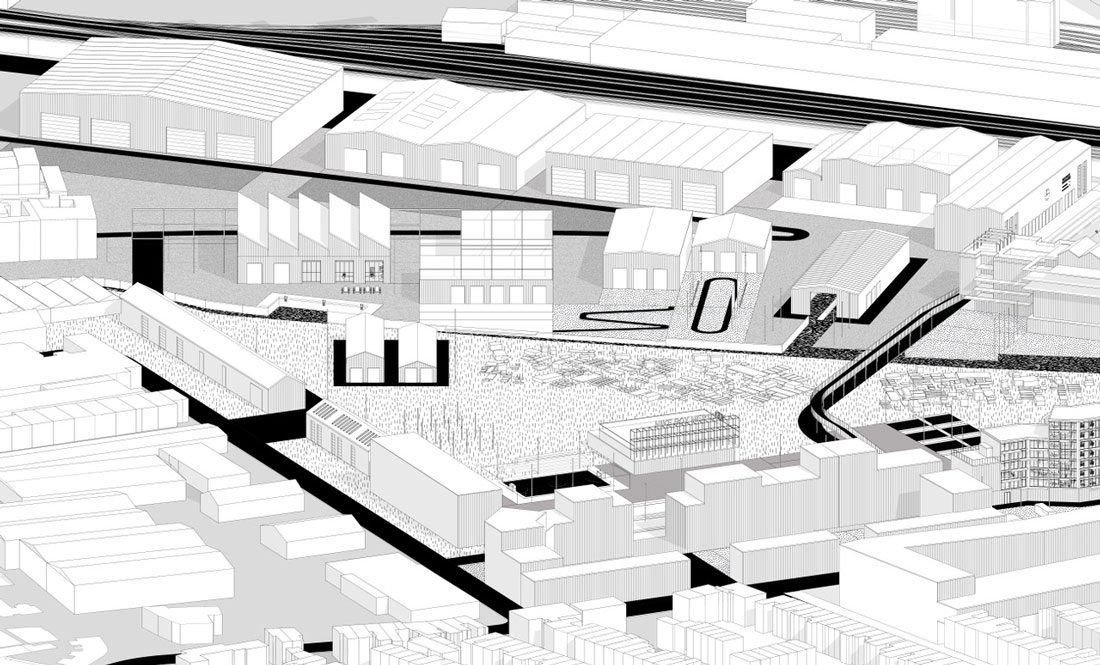
There is a type of area that we often consider appropriate for care environments like nursing homes, homes for the elderly, assisted living, etc. These areas are often characterized by amazing landscapes, access to water and relatively quiet and calm settings in general. However, this also means that such care venues usually end up in isolation from the central city environments as the desire for privacy, quietness and a certain level of security seems to be the dominant consideration in their design process. If we agree to look at the potential of care ecologies in their urban value and their ability to rethink our neighborhoods, then the first step would be to consider areas in our cities that are well-connected to the central city but still offer the qualities we value so much in relation to care. In this case, we would suggest shifting our attention to the inner periphery of the city, which offers a fabric that is free from the ‘straitjacket of identity’ that we inevitably face when working in central city environments.
One of the corridors that offers these conditions is the inner-peripheral area on the South Bank of London, located along the river Wandle, stretching from the borough of Wandsworth in the North to Sutton in the South. Exceptionally well located in relation to the inner city, the Wandle river trail offers access to landscape that is almost rural in character, vast open green areas and clean water that supports biodiversity in the area. However, like many other areas in London that are located along the water routes, the Wandle river is still dominated by the industrial hubs, storage and service centres that represent the ‘furious industrial activity’ of its past.
There is a distinctive transition in terms of the development models and type of settings found along the Wandle, moving from the Thames waterfront towards the southern end of the corridor. In no small part due to the improved transport links in recent years, the waterfront is considered an area of opportunity and high market value and is beginning to be dominated by commercially oriented developments and regeneration schemes emerging around district centres. The fabric further to the South constitutes a combination of the ‘London vernacular’ villages: endless strips of terraced housing, underperforming high-street environments and large-scale post-industrial hubs. Juxtapositions of scale are found between the extra-small of the terraced houses and minor industrial structures and the extra-large storage and service sheds, with the medium scale of both housing and industry missing from the bigger picture. The broken character of the fabric is strengthened by the large infrastructure of the railway lines, the river itself and by extensive areas of parks, wild nature, etc. Both the post-industrial and the nature landscapes in the area are currently under-utilized. The patterns of land ownership and plot dimensions and borders are historically challenging in the area. In combination with the lack of a common framework and vision for change, this results in independent developments that happen regardless of their impact on the future of the neighborhoods and are unable to create benefits for a wider urban area.
Today, the Wandle corridor is considered a very attractive area for young families and those who have kids. It is thanks to the layered infrastructure of schools, nurseries, sport facilities and different versions of child-care. In addition to that, it is also home to St. George’s hospital, one of the largest research and healthcare institutions not only in South London but in the whole city. The question is: are we doing enough to benefit from the phenomenal stretch along the river Wandle, all the layered infrastructure it offers, its landscape resources and heterogenous morphology? We would claim that, in words of Duplex architects, this heterogeneity ‘has a potential of transforming the direct juxtaposition into a high-contrast coexistence.’ A new version of care ecology could be fundamental to transformation in this area but is unthinkable today in the context of the kinds of care environments that we are dealing with today in health and well-being.
This thesis puts forward a design-led project located on the border between the Merton and Wandsworth councils, within the North Wimbledon/Garrett Business Park area. It occupies a 15 ha. site and works with partial requalification of the existing industrial area. It puts forward an adaptable urban strategy and typological framework with a goal of requalifying the area into a productive neighborhood that can potentially boost transformation of a wider urban area and become a part of a rethought Wandle corridor.

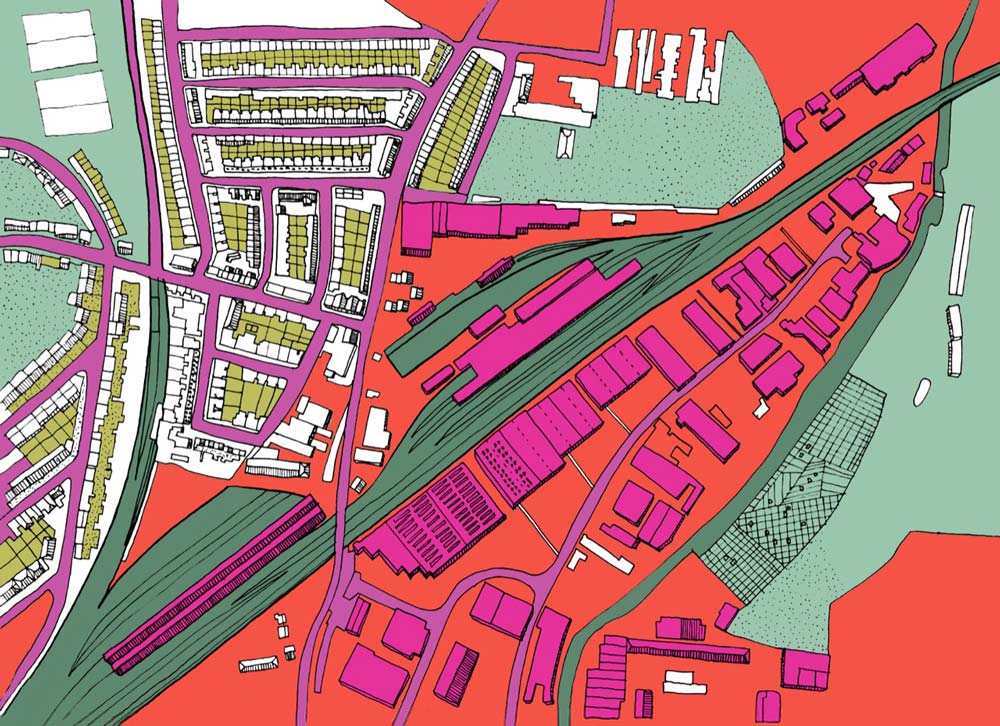
Although, in general, the morphology of the Wandle trail comes across as broken and irregular, there are consistencies to be found if we zoom out and look at the corridor holistically. The high-street, railway and Wandle armatures emphasize the prevalence of the North-South axis of the corridor and start forming distinctive post-industrial enclaves along the water. Following David Graham Shane, each of these enclaves can be read as a ‘recombinant assemblage’ working on the basis of ‘neighbor-to-neighbor relationships’ of the fragments, as ‘an unpredictable, self-organized system with strictly local rules that can nonetheless produce predictable large-scale patterns.’
Within the disjunctions and irregularities of the enclave fabric certain strong urban conditions can be found. For the purposes of this research, three of them are rethought. They are: the industry, the park, and the high street. At the moment each of these conditions presents its own conflicts.
- The issue of losing employment lands to housing has become urgent in the UK in recent years. However, an attempt to continuously retain industrial land leads to the creation of conservation areas, and the strategies offering crossovers between production and housing often end in a ‘limited promise, seized upon as a nostalgic dream, thereby unconsciously transformed into an unsatisfying theme park.’ Crossovers with a new care ecology could help us to retain viability of the employment lands by broadening the set of businesses they can support.
- We are shifting our attitude to the role parks have to play in our cities today from ‘negative’ green spaces to places promoting event-led urbanity and a different culture of using green and blue infrastructure that is more civic oriented and activity-based.
- Today the traditional high-street so typical for residential areas of London is struggling to redefine its purpose. We see the need to shift away from a concentration of commerce to a less linear and more layered way of organizing our daily rhythms.
As a result, we tend to separate these environments to generate dedicated city spaces for production and logistics, for leisure and sport, and for everyday activities associated with home, family and work respectively. The fact that they overlap only for a limited amount of time, and do so ineffectively, is the reason why areas like the one we are investigating are under-performing.
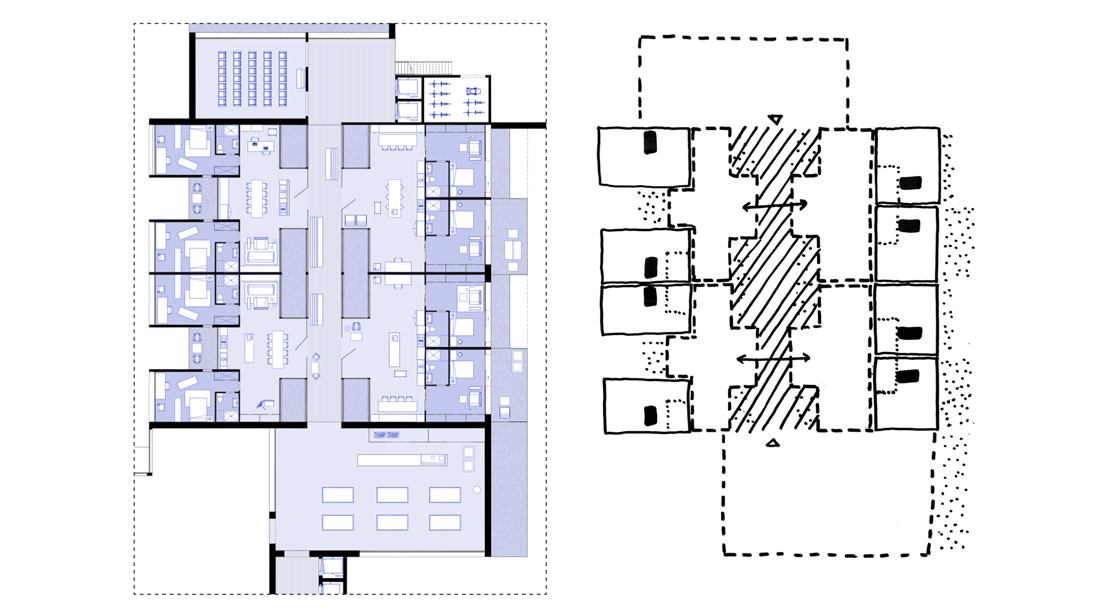
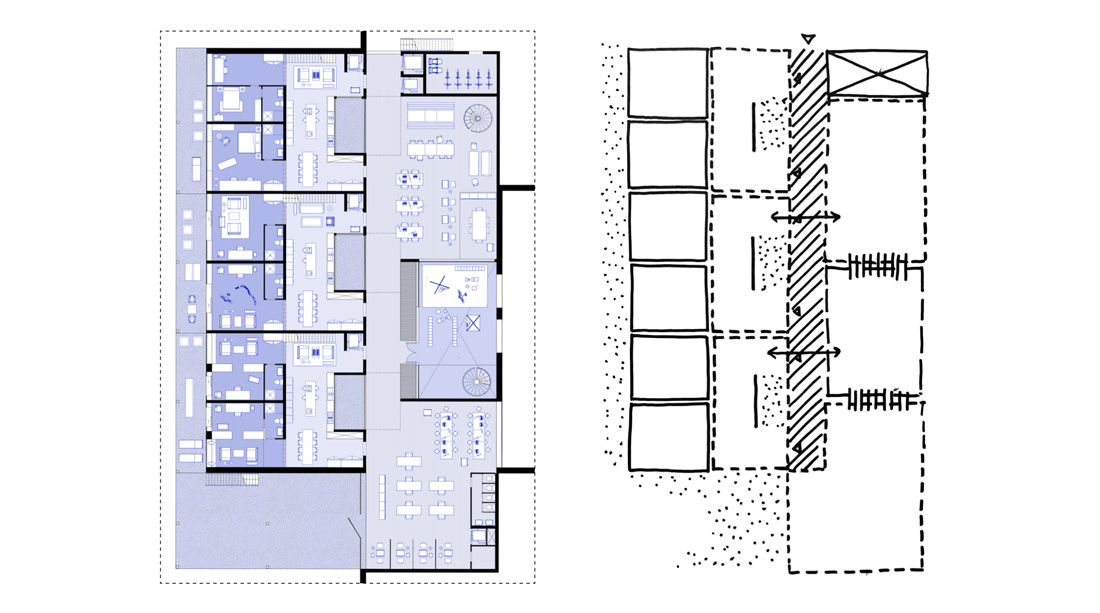
To start changing the way the enclave operates today and to address the challenge of separation described above, this thesis suggests rethinking the way service delivery is currently organized on the site. Right now, the heavy mobility and logistics routes are spread within the industrial part of the area with the main access road located between the sheds. Therefore, the space between the industrial structures is compromised by the parking of heavy machinery and delivery trucks and vans. As a result, the connection to the land in the northern part of the site is restricted, in addition to the railway line running in the West and river in the East. This makes it challenging for any substantial development to come in and start forming a dialogue with the industrial land.
A solution put forward by the project is to organize a separate service corridor between the back of the sheds and the lifted railway line by disassembling part of the sheds’ structure and shifting their borders farther in. This could unload the logistics and servicing demands off the industrial yards and turn them into much more purposeful civic-oriented spaces engaging with the waterfront and accessible for the local residents. The goal is not to mask the activity that belongs to the realm of the sheds. On the contrary, the space between them can still be productive and used as a working yard. However, all the ‘disruptive’ mobility is handled in a much more systematic way and allows for unlocking the possibility of a different landscape. In order to allow for seamless and quick turning of large vehicles in the corridor, as well as creating a dedicated parking area for them, one of the existing sheds is transformed into a garage.
Paying attention to the way the buildings on the site are currently organized, one notices that although the North-South axis is dominant, the east-west direction is already registered in the way the industrial structures are organized on the site. They form an array located almost perpendicular to the waterfront. This existing parcellation provides a system of striations that run through key armatures (the railway, the river, and the road). It also gives a sense of dimensions and helps to locate the project as something that establishes balance and integration within a wider circulatory system.
The project uses the existing directions formed by this array and transforms them into physical links: the new light mobility routes crossing the river and connecting the industrial land and new clusters to the high street on the other side. This way the waterfront becomes an extension of the buildings’ organization logic and part
of the everyday life activities of the residents, putting emphasis on actively engaging with the water. The existing park in the middle of the site becomes a crucial element in negotiating between all the elements of the site. Right now this green area is treated almost like a backyard of the residential fabric and the high-street and is under-performing.
Zooming out, the urban area of each enclave along the river Wandle can be thought of as a node within a larger system. On the basis of understanding the form and potential of each of these urban areas we can start conducting design investigations. These investigations would have an aspiration of turning what is currently the Wandle corridor into a series of well-defined, highly performing neighborhoods, where the strength of the enclaves system lies in the proximity and the accessibility of ‘the other.’ Enclaves, despite their independent position, are a boon for the city as a whole. They can give the city the layeredness and multifaceted identity fitting to our present-day society.
| ISSN : 2575-5374 |